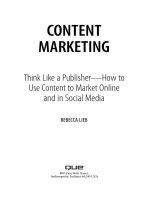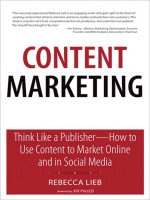Content marketing think like a publisher chapter 24 remaking, remodeling, and repurposing content
Bạn đang xem bản rút gọn của tài liệu. Xem và tải ngay bản đầy đủ của tài liệu tại đây (226.42 KB, 4 trang )
24
Remaking, Remodeling,
and Repurposing
Content
“Every marketer with half a brain knows viral isn’t something you can buy in
a bottle.”
Everyone knows glass is recyclable. Until recently, no one
realized just how far glass recycling could go in a digital
environment. A video made for a Corning investor event
in early 2011 has (much to the surprise of Corning executives and its agency) gone mega-viral on YouTube. With
upward of eight million views in four short weeks, it’s the
most-watched corporate video in YouTube history. Maybe
even in all of corporate video history.
Every marketer with half a brain knows viral isn’t something you can buy in a bottle. And if it were, it wouldn’t
come with a guarantee. But what smart marketers who
invest time and dollars into content creation do know is
that reusing and recycling that content can far extend the
reach of their message and the return on investment (ROI)
of their spend.
190
Part IV
I t ’s N e v e r O v e r — P o s t - P u b l i c a t i o n
Take Sony’s breathtaking, award-winning Bravia ads from circa 2006–2007. Users
and fans—not Sony or its agency—uploaded them to YouTube where they live in
perpetuity, garnering in toto some five million views.
Small wonder advertisers got in on the action. Chrysler’s ad from the 2011 Super
Bowl has enjoyed more than nine million views on the company’s YouTube channel, extending reach and justifying some of that enormous spend on creative.
Yet recycling content is hardly reserved for the big boys. Small businesses, mom ‘n’
pops, and even individuals polishing their personal brands online are learning that
if content marketing counts, extending the life and the reach of that content makes
it count oh, so much more.
Simple, right? Only too few marketers make content recycling part of a content
marketing strategy.
Slice ‘n’ Dice
The Internet runs on content and offers seemingly endless distribution options for all kinds of
media: text, images, video, audio, you name it.
Yet content creation can be hard. It requires
thought. Ideas. Strategy. Data. Production.
Editing. Originality. Relevance. Targeting.
“Creative is
hard. Recycling
is relatively
easy.”
After you’ve produced a strong piece of content,
the goal should be to leverage it in different
channels, different formats, and different media for maximum impact. Creative is
hard. Recycling is relatively easy—and increasing reach is nothing to sneeze at.
For example, say you (or a company executive) are speaking at an industry event.
The speech? New content. That’s a lotta work. But look at it this way: In the run-up
to the event, it lightens the load in other areas. You can blog and tweet about the
upcoming talk. Not just promote it, mind you, but drip out tantalizing bits of information and perhaps data or finding that will encourage attendance.
Now that the speech is done and delivered, you did remember to do a video of its
delivery, didn’t you? In whole or in parts, the speech can go on your site, your blog,
YouTube, you name it. Perhaps the audio is appropriate for a podcast. Transcribe
the presentation both to boost SEO rankings of the audio and video and perhaps as
a stand-alone text marketing piece. (Email newsletter, anyone?)
The presentation itself? Up onto Slideshare it goes. Extract charts, infographics, and
other nuggets of easy-to-digest visual data to build short-burst content around.
Chapter 24
Remaking, Remodeling, and Repurposing Content
191
Can the talk be turned into—or incorporated into—a whitepaper? An ebook? Is
there something newsworthy in it that’s press-releasable? Perhaps it’s webinar material, with just the right amount of tweaking.
Note this approach doesn’t just apply to a one-off event such as a speech. When a
content marketing editorial calendar is mapped, part of the process is to determine
how to tweet each blog post, and once a post goes up, how to recycle its essence
into other content marketing channels such as articles, videos, and newsletters.
As You Listen, So Shall You Create Content
Customers and prospects are likely shoving all kinds of content in your direction.
You could use it—if only you were listening.
What questions and topics of discussion arise most frequently in user forums and
in discussion around your brand—or product category—in social media channels?
Taking a cue from consumer issues, questions, and resolutions enables you to create
how-to content, useful FAQs, and user manuals. Listening could even result in content that funnels in to product development.
It’s Doubtful You’ll Be Repeating Yourself
Post-Thanksgiving eating is an analogy that could apply to content recycling.
There’s roast turkey on the big day, followed by turkey hash, turkey sandwiches, and
cold turkey sliced in salad. Perhaps someone whips up a pot of turkey chili. When
you’re eating at home, all that turkey is likely feeding the same audience.
That’s not necessarily so with content. In fact, it’s unlikely. Your own analytics will
bear this out, but it’s improbable there’s terribly significant overlap between your
newsletter subscribers, Facebook and Twitter followers, and the people who read
your blog. Different segments have different content appetites: the form, the length,
the medium, and the channel. And in case you haven’t noticed, there’s a lot of content out there. Brand impressions and engagement count.
So do learnings about format, channels, style, and the relative length or brevity of
your content. Recycling not only frees you from the burden of being a virtual newidea factory, it’s also a sandbox in which you can experiment with what’s working—
and with whom.
This page intentionally left blank









